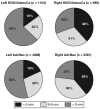Polyps with advanced neoplasia are smaller in the right than in the left colon: implications for colorectal cancer screening
- PMID: 22835574
- PMCID: PMC3595198
- DOI: 10.1016/j.cgh.2012.07.004
Polyps with advanced neoplasia are smaller in the right than in the left colon: implications for colorectal cancer screening
Abstract
Background & aims: Colonoscopy is consistently associated with reduced left-sided, but not right-sided, colorectal cancer (CRC) incidence and mortality. This might be because polyps with advanced pathology are smaller and more easily missed in the right vs left colon. We explored this postulate by evaluating the relationship among size, location, and histology of polyps from a large nationwide sample.
Methods: We conducted a cross-sectional study of 233,414 polyps from 142,686 patients (47% women; mean age, 60 years), which were reviewed by Miraca Life Sciences in 2009. We assessed polyp histology, location, and size of largest fragment submitted. We compared size distribution of right vs left polyps with high-grade dysplasia (HGD) or adenocarcinoma as well as any advanced neoplasia.
Results: The average size of right-sided polyps was smaller than that of left-sided polyps with HGD or adenocarcinoma (8.2 vs 12.4 mm, respectively); the same was true for polyps with advanced neoplasia (7.6 vs 11.1 mm, respectively) (P < .001). Most right-sided polyps with HGD, adenocarcinoma, or any advanced neoplasia were ≤9 mm, whereas most left-sided polyps with these findings were >9 mm. Polyps with advanced pathology were 5-fold more likely to be <6 mm in the right vs left colon: odds ratio, 5.27; 95% confidence interval, 4.06-6.82 for HGD or adenocarcinoma; odds ratio, 4.89; 95% confidence interval, 4.34-5.51 for advanced neoplasia.
Conclusions: Polyps with features of HGD, adenocarcinoma, or advanced neoplasia were significantly smaller in the right vs left colon. Strategies to prevent right-sided CRC require more accurate detection of small, advanced polyps.
Copyright © 2012 AGA Institute. Published by Elsevier Inc. All rights reserved.
Conflict of interest statement
Figures


Similar articles
-
Relationship between the endoscopic withdrawal time and adenoma/polyp detection rate in individual colonic segments: a KASID multicenter study.Gastrointest Endosc. 2019 Mar;89(3):523-530. doi: 10.1016/j.gie.2018.09.016. Epub 2018 Sep 26. Gastrointest Endosc. 2019. PMID: 30267654
-
Increasing prevalence of right-sided colonic adenomas in a high-volume endoscopy department in Romania: implications for colorectal cancer screening.J Gastrointestin Liver Dis. 2014 Jun;23(2):147-51. doi: 10.15403/jgld.2014.1121.232.iiv1. J Gastrointestin Liver Dis. 2014. PMID: 24949606
-
Endoscopic appearance of proximal colorectal neoplasms and potential implications for colonoscopy in cancer prevention.Gastrointest Endosc. 2012 Jun;75(6):1218-25. doi: 10.1016/j.gie.2012.02.010. Epub 2012 Apr 5. Gastrointest Endosc. 2012. PMID: 22482917
-
The primary tumor location impacts survival outcome of colorectal liver metastases after hepatic resection: A systematic review and meta-analysis.Eur J Surg Oncol. 2019 Aug;45(8):1349-1356. doi: 10.1016/j.ejso.2019.04.017. Epub 2019 Apr 25. Eur J Surg Oncol. 2019. PMID: 31054852
-
[Right- and left-sided colonic cancer - different tumour entities].Zentralbl Chir. 2010 Aug;135(4):312-7. doi: 10.1055/s-0030-1247471. Epub 2010 Aug 30. Zentralbl Chir. 2010. PMID: 20806133 Review. German.
Cited by
-
A structured light laser probe for gastrointestinal polyp size measurement: a preliminary comparative study.Endosc Int Open. 2018 May;6(5):E602-E609. doi: 10.1055/a-0577-2798. Epub 2018 May 8. Endosc Int Open. 2018. PMID: 29756018 Free PMC article.
-
The Association between Distal Findings and Proximal Colorectal Neoplasia: A Systematic Review and Meta-Analysis.Am J Gastroenterol. 2017 Aug;112(8):1234-1245. doi: 10.1038/ajg.2017.130. Epub 2017 May 30. Am J Gastroenterol. 2017. PMID: 28555635
-
Increase your adenoma detection rate without using fancy adjunct tools.Tzu Chi Med J. 2018 Jul-Sep;30(3):127-134. doi: 10.4103/tcmj.tcmj_86_18. Tzu Chi Med J. 2018. PMID: 30069119 Free PMC article. Review.
-
Long-Term Colorectal Cancer Incidence After Negative Colonoscopy in the State of Utah: The Effect of Family History.Am J Gastroenterol. 2017 Sep;112(9):1439-1447. doi: 10.1038/ajg.2017.193. Epub 2017 Jul 11. Am J Gastroenterol. 2017. PMID: 28695908
-
CMOST: an open-source framework for the microsimulation of colorectal cancer screening strategies.BMC Med Inform Decis Mak. 2017 Jun 5;17(1):80. doi: 10.1186/s12911-017-0458-9. BMC Med Inform Decis Mak. 2017. PMID: 28583127 Free PMC article.
References
-
- Siegel R, Ward E, Brawley O, et al. Cancer statistics 2011: the impact of eliminating socioeconomic and racial disparities on premature cancer deaths. CA Cancer J Clin. 2011;61:212–236. - PubMed
-
- Jemal A, Center MM, DeSantis C, et al. Global patterns of cancer incidence and mortality rates and trends. Cancer Epidemiol Biomarkers Prev. 2010;19:1893–1907. - PubMed
-
- Levin B, Lieberman DA, McFarland B, et al. Screening and surveillance for the early detection of colorectal cancer and adenomatous polyps, 2008: a joint guideline from the American Cancer Society, the US Multi-Society Task Force on Colorectal Cancer, and the American College of Radiology. Gastroenterology. 2008;134:1570–1595. - PubMed
-
- Baxter NN, Goldwasser MA, Paszat LF, et al. Association of colonoscopy and death from colorectal cancer. Ann Intern Med. 2009;150:1–8. - PubMed

